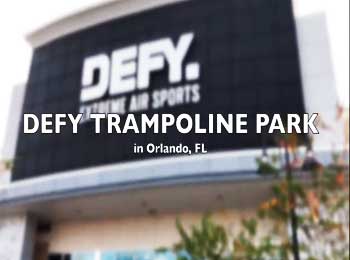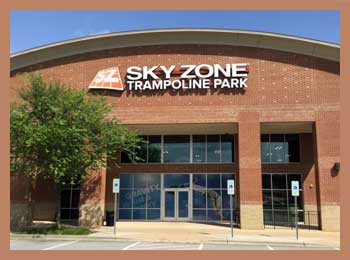Looking for a place to let kids bounce off the walls? Defy and Sky Zone are two of the largest indoor trampoline park chains with locations across North America. As fierce competitors in the family entertainment space, they offer similar attractions and experiences.
But with differences in branding, policies, and pricing, how do you decide between Defy and Sky Zone for your next outing? This comprehensive guide covers all the key comparison points.
A Brief Comparison Table
| Aspects | Defy | Sky Zone |
| Founded | 2015, Virginia | 2004, Las Vegas |
| # of Locations | 40+ | 140+ worldwide |
| Target Audience | Teens/Young Adults | All Ages Families |
| Aesthetics | Sleek, monochrome | Bright, colorful |
| Attractions | Foam pits, warped walls, basketball | Foam pits, warped walls, basketball, dodgeball |
| Parties | Teen focused, late hours | Kid focused, photo booths |
| Food/Drink | Coffee bar, upscale snacks | Standard fast food and snacks |
| Pricing | $12-$18 for 60 min jump | $12-$16 for 60 min jump |
| Age Minimum | 14+ unsupervised | 6+ unsupervised |
A Brief Background on Defy and Sky Zone
Defy was founded in 2015 in Manassas, Virginia by entrepreneur Stephen Lowry. Marketed as a “pro social hangout” with a sleek, modern vibe, Defy has expanded to over 40 locations in the U.S. and Canada.

The brand targets an older audience, positioning itself in the “out-of-home social amusement” space.
Sky Zone opened its first location in Las Vegas in 2004, founded by entrepreneur Rick Platt. It quickly became the fastest-growing franchise in the U.S. at the time.
With over 140 parks worldwide today, Sky Zone aims for a family-friendly, high-energy environment. It helped pioneer trampoline dodgeball and other attractions.
So while Defy caters more to teens and young adults with its branding, Sky Zone maintains a multi-generational appeal with attractions suitable for all ages. Both saw rapid growth by bringing trampoline-based activities indoors.
Also Read: Comparison Between Sky Zone and Rockin’ Jump
Key Differences Between Defy and Sky Zone
As above we’ve discussed about the basics about them. Now we’ll compare them with details informative details:
1. Main Attractions and Activities
As indoor trampoline park competitors, Defy and Sky Zone offer similar core attractions:
Open Jump Areas
- Wall-to-wall trampolines for open bouncing
- Slam dunk basketball hoops at both
- Equipped with angled trampolines and launching features
Foam Pits
- For climbing, stunts, and pit jumps
- Dodgeball at Sky Zone pits
Warped Walls
- Inspired by American Ninja Warrior
- Climb and scale sloped walls
Performance Trampolines
- Individual trampolines for routines and tricks
Arcades
- Redemption and video games
- Defy focuses more on arcade experience
Defy offers a Battle Beam and Sky Zone has a climbing wall. But overall, you’ll find the same main attractions at both companies’ parks, including fitness classes. Defy just brands itself as more sleek, hip, and tailored to young adults.
2. Food, Beverage, and Party Options
Small café-style food counters can be found at most locations of both chains:

- Hot dogs, pizza, nachos, pretzels
- Slushies, sodas, sports drinks
- Ice cream, candy, and snacks
Both Defy and Sky Zone provide private party rooms and event packages for birthdays and group events. You can add extras like catering, decorations, and gifts. This makes trampoline parks a go-to option for high-energy kid parties or teen hangouts.
The main differentiation is that Sky Zone sometimes offers additional party services like photo booths. But basic amenities are very similar.
3. Safety Policies and Guidelines
To minimize risk with all the high-flying activities, both trampoline brands implement key safety rules:
- Signed waivers required from all jumpers
- Traction grip socks mandatory
- No flips or rough horseplay allowed
- Height/age/weight restrictions enforced
Staff members supervise all areas to ensure policies are followed, stopping any dangerous behavior immediately. This keeps the environment safe for kids while still allowing freedom to bounce actively.
Defy and Sky Zone take very similar precautions through staff monitoring, proper footwear, rules against stunts, and height/age policies in certain areas.
4. Pricing and Membership Options
Here’s an overview of standard pricing at Defy and Sky Zone as of 2023:
Open Jump
- 60 minutes: $12-$18 per person
Day/Monthly Passes
- Day pass: $20-$30
- Monthly: $60-$80
Sock Rentals
- $2-$3 per pair
Party Packages
- Start at $300 for 10 kids
Group Events
- $20-$40 per person per hour
Pricing is very aligned between the two brands for walk-in admission, passes, rentals, parties, and events. Defy skews slightly higher for individual jump sessions. But overall affordability is comparable.
Both also offer memberships with perks like free socks, bonus jump time, and discounts. This allows regular visitors to save some money.
Which Brand Has More Locations?
With over 140 parks spanning 4 countries, Sky Zone dwarfs Defy’s 40+ locations in terms of geographic footprint. Even where they directly compete in certain metro areas, Sky Zone usually has more parks in the region.
For example, in Dallas-Fort Worth where both brands have a strong presence, there are 9 Sky Zone locations versus 4 Defy outlets as of 2023. Sky Zone also continues expanding into new markets worldwide.
So while Defy serves major cities across North America, Sky Zone will likely have broader access and availability for customers. Defy’s smaller footprint gives it a boutique feel by comparison.
How Do Defy and Sky Zone Stand Apart?
Defy and Sky Zone offer such similar trampoline park experiences that distinguishing factors come down to branding, aesthetics, and subtle policy differences:
Branding
- Defy uses sleek, modern visual identity for older crowd
- Sky Zone aims for multi-generational family market
Aesthetics
- Defy locations feature monochrome and colorful LED lighting
- Sky Zone parks bulk up on bright colors, graphics, and theming
Parties
- Defy allows teen parties until 2 AM with add-ons like DJs
- Sky Zone has more dedicated kids party offerings
Food
- Defy focuses on higher-end coffee drinks and snacks
- Sky Zone provides standard fast food fare
Policies
- Defy sets 14+ age minimum for unsupervised jumpers
- Sky Zone policies accommodate younger ages
So Defy tailors to older teens and young adults with its cutting-edge aesthetics, coffee bar vibes, and extended party hours. Families with very young kids may lean toward Sky Zone’s brighter, cartoonish locations with dedicated preschool areas.
Also Read: Comparison Between DEFY Trampoline Parks Vs. Urban Air Adventure Parks
Frequently Asked Questions (FAQs)
Before visiting Defy or Sky Zone, here are answers to some common questions:
No, Defy and Sky Zone are competing brands offering similar trampoline park experiences. But they are wholly separate companies since launching just a year apart in the mid-2000s.
Sky Zone allows kids under 6 in designated “preschool zones.” Children ages 6-13 can access all attractions under supervision. Kids 14+ can jump without supervision with a signed waiver.
As of 2023, Sky Zone has over 140 trampoline park locations in 4 countries including the U.S., Canada, Mexico, and Australia. It continues expanding worldwide.
Some Sky Zone locations have café areas serving beer and wine to adult guests. This varies by region based on alcohol policies. Sky Zone encourages responsible drinking.
Sky Zone is likely the better choice for very young kids thanks to their dedicated preschool areas. Defy sets a 14+ policy for unsupervised jumpers, while Sky Zone accommodates younger ages.
The Final Take
When it comes to wall-to-wall aerial action, Defy and Sky Zone offer almost identical trampoline park thrills. No matter which brand you leap into, you’ll find exciting attractions like foam pits, warped walls, basketball slams, stunt zones, and wide open jump spaces. Add tasty snacks and party rooms, and these parks make for ideal high-energy kids birthdays or teens nights out.
Defy positions itself for a sleeker, older demographic with a modern look, extended hours, and coffee bar. But Sky Zone provides more breadth with dedicated preschool areas, signature dodgeball, and a wider geographic footprint.
In the end, choosing between these fierce competitors comes down to location convenience and which branding and vibe resonate most with your family or group. With similar safety policies and pricing in place at both chains, you really can’t go wrong for accessible trampoline fun.
So whether you’re a parent looking to tire out your energetic kids or a group of teens bouncing between dodgeball matches, Defy and Sky Zone are top options for next-level jumping. Just don’t forget your grip socks!
